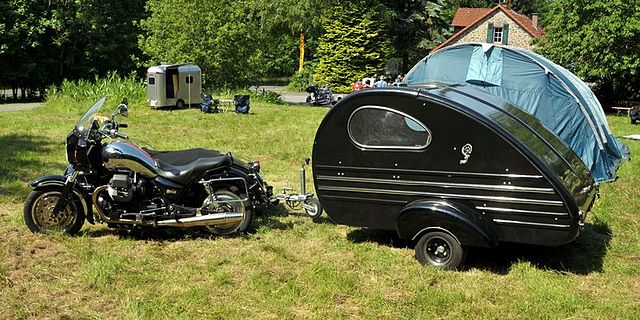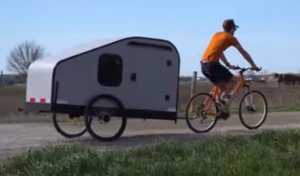In a previous post, we looked at homemade micro campers that could be pulled by hand, by sheep, by bicycle, and by ATV or snowmobile. But if you need a bit more room or need to travel farther than where a bike can take you, and you have a motorize vehicle available to you, then check out this next step up in campers. These are all still considered micro-sized, but they’re larger than what we looked at previously and are roadworthy. Several of these can be pulled by motorcycles and all can be handled by a small car (one manufacturer in the UK said their camper could be pulled by electric cars as well); no truck or SUV needed. The smallest of these campers is nothing more than a bed with a tent over it, but some of them can be surprisingly spacious.
If you are hauling with a motorcycle, storage space will be the largest concern. The campers have some storage space inside them, but this will be quickly taken up by things you need for long-term living, like a potty, chair and small folding table, some sort of sink and equipment for dishwashing, a stove, cooler, etc. All the models I looked at have attachment points on the roof that effectively make a luggage rack, but some have the option of adding a dedicated rooftop cargo container, like you can get for a car. I also saw one offering a storage box on the tongue. These external storage options would be necessary for storing your clothing and food.
If you are hauling with a car, you can also make use of external storage areas, but your car is the obvious place to store things, and it opens up a lot of possibilities for more amenities.
If you go with a manufactured trailer, expect to pay $3500-$7500 for one new. (This would be a monthly payment of about $150 for 2 years at 6.5% interest for the cheapest camper, and about $225 a month a month for 3 years at the same interest rate for the most expensive.) Based on the price of of some of the homemade bicycle campers, you should be able to make a homemade motorcycle/car version for $1,000-$2,000, depending on how many materials you can get used or for free.
Homemade Micro House
Your cheapest option for a camper is to make one yourself using a small utility trailer as a base. The rest of the materials can be recycled or surplus, allowing you to customize it based on your needs and priorities, while keeping it cheap.
This one can be pulled by an ATV, but in other videos, he does take it places with a vehicle, so it is roadworthy. Compared to the bicycle campers, this one is sturdy and will hold up to the wear and tear of living for longer. Its insulation value is also going to make it easier to live in during hotter and colder seasons.
Homemade Teardrop
If you like the style of the teardrop campers (lower profile when hauling, external kitchen), here’s a homemade version. With a new Harbor Freight utility trailer, the cost was about $2,000. It’s too heavy for a motorcycle but most cars should be able to tow it (check your owner’s manual). One feature is that it’s completely detachable from the trailer, so if you have a place to set it up on blocks, you can do so and you can use the trailer to use for hauling.
Pop-Up Motorcycle Campers
This video features 10 motorcycle campers. Most of them are popup campers, which makes them light and easy to pull, but they come with some drawbacks. For instance, if you have to pack up when your canvas is wet, you have to get somewhere to set it back up as quickly as possible or it will mold (which, in turn, creates leaks). It’s also much harder to heat and cool them because they lack insulation. The benefit to a pop-up camper as opposed to one of a fixed size, like the first option on this list, is they can pop out to be much larger. So if you are a tall person or have claustrophobia, these will provide more room and allow you to feel more comfortable.
Mega Pop-Up Motorcycle Camper
This pop-up motorcycle camper is as big as you can get; you are not likely to feel claustrophobic in it. There’s about as much available space in this as in the pop-up camper we had when I was a teenager. It even has the same sort of table built into it. But be aware, other than the table, you’re just getting a large, empty room. Unlike a traditional pop-up camper, there are no cabinets and countertops, no sink or stove, and no mattress. All the things you need to live in the camper will have to either fit into the camper itself, or in your luggage rack/car.
Customizable Tear Drop
This lightweight tear-drop camper may be haulable by a motorcycle (especially a larger model, like a trike); fully loaded, it can be hauled by anything with a 1,000 lb. hauling capacity. That should include cars of just about any size. It has some nice upgrade options, like a vent fan, and I like how they have all the electrical components in one area, ready to be plugged into a solar generator or shore power. Even with the upgrades, though, it is very plain. This may be a selling feature if you like the idea of customizing your camper, but you lack the necessary carpentry skills and/or equipment to build the entire thing yourself. Some Ikea organizational units or just some plastic bins and drawer sets from Wal-Mart will give you a functional space. The model shown has an exterior kitchen setup, but they also sell a model that has nothing in the rear. This would allow you to build out a kitchen that’s turned to the inside if you prefer.
Hard-Side A-Frame Pop-Up
This A-frame pop-up camper is a bit bigger than the other campers featured, but should be towable by most cars. It has a lot more storage space inside if you have equipment or supplies you need to keep with you for your job or hobbies. It will technically work for 2 people, since the dinette table makes a second bed, but I think this would be cramped. (Although not more so than two people in an SUV.) For one person, this is not a bad size. The obvious drawback is the height; this is not a camper for someone who is 6 feet tall. But it would make a great camper for a solo female nomad as it is easy to set up and should be light enough to allow you to push it into place when hitching up. (A wheel is not shown on the tongue support, but is a game changer; I bought a wheel mount for my little utility trailer and it makes life much easier.)
Are these options a little too small or impractical? Check out this post for more nomad options: On the Road Again – Exploring Nomadic Housing Options


